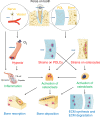Biomechanical and biological responses of periodontium in orthodontic tooth movement: up-date in a new decade
- PMID: 34183652
- PMCID: PMC8239047
- DOI: 10.1038/s41368-021-00125-5
Biomechanical and biological responses of periodontium in orthodontic tooth movement: up-date in a new decade
Abstract
Nowadays, orthodontic treatment has become increasingly popular. However, the biological mechanisms of orthodontic tooth movement (OTM) have not been fully elucidated. We were aiming to summarize the evidences regarding the mechanisms of OTM. Firstly, we introduced the research models as a basis for further discussion of mechanisms. Secondly, we proposed a new hypothesis regarding the primary roles of periodontal ligament cells (PDLCs) and osteocytes involved in OTM mechanisms and summarized the biomechanical and biological responses of the periodontium in OTM through four steps, basically in OTM temporal sequences, as follows: (1) Extracellular mechanobiology of periodontium: biological, mechanical, and material changes of acellular components in periodontium under orthodontic forces were introduced. (2) Cell strain: the sensing, transduction, and regulation of mechanical stimuli in PDLCs and osteocytes. (3) Cell activation and differentiation: the activation and differentiation mechanisms of osteoblast and osteoclast, the force-induced sterile inflammation, and the communication networks consisting of sensors and effectors. (4) Tissue remodeling: the remodeling of bone and periodontal ligament (PDL) in the compression side and tension side responding to mechanical stimuli and root resorption. Lastly, we talked about the clinical implications of the updated OTM mechanisms, regarding optimal orthodontic force (OOF), acceleration of OTM, and prevention of root resorption.
Conflict of interest statement
The authors declare no competing interests.
Figures





References
-
- Danz JC, et al. A rat model for orthodontic translational expansive tooth movement. Orthod. Craniofac. Res. 2013;16:223–233. - PubMed
Publication types
MeSH terms
LinkOut - more resources
Full Text Sources

